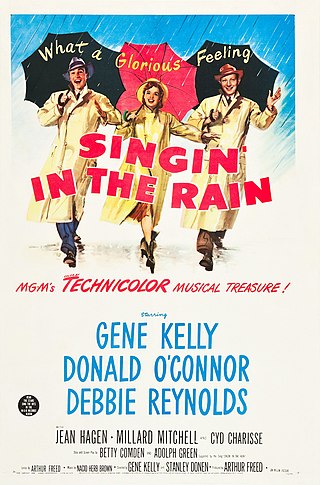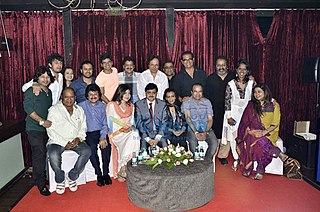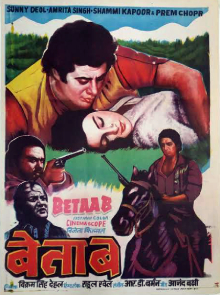Related Research Articles

Hindi cinema, popularly known as Bollywood and formerly as Bombay cinema, refers to the film industry based in Mumbai, engaged in production of motion pictures in Hindi language. The popular term Bollywood is a portmanteau of "Bombay" and "Hollywood". The industry is a part of the larger Indian cinema, which also includes South Indian cinema and other smaller film industries.

Musical film is a film genre in which songs by the characters are interwoven into the narrative, sometimes accompanied by dancing. The songs usually advance the plot or develop the film's characters, but in some cases, they serve merely as breaks in the storyline, often as elaborate "production numbers".

Urdu is an Indo-Aryan language spoken chiefly in South Asia. It is the national language and lingua franca of Pakistan, where it is also an official language alongside English. In India, Urdu is an Eighth Schedule language, the status and cultural heritage of which are recognised by the Constitution of India; and it also has an official status in several Indian states. In Nepal, Urdu is a registered regional dialect and in South Africa it is a protected language in the constitution. It is also spoken as a minority language in Afghanistan and Bangladesh, with no official status.

Hindustani is an Indo-Aryan language spoken in Deccan, Northern India and Pakistan, and used as a lingua franca in both countries. Hindustani is a pluricentric language with two standard registers, known as Hindi and Urdu. Thus, it is also called Hindi–Urdu. Colloquial registers of the language fall on a spectrum between these standards. In modern times, a third variety of Hindustani with significant English influences has also appeared which is sometimes called Hinglish or Urdish.

Javed Akhtar is an Indian screenwriter, lyricist and poet. Known for his work in Hindi cinema, he has won five National Film Awards, and received the Padma Shri in 1999 and the Padma Bhushan in 2007, two of India's highest civilian honours.
Hindustani is one of the predominant languages of South Asia, with federal status in the republics of India and Pakistan in its standardized forms of Hindi and Urdu respectively. It is widely spoken and understood as a second language in Nepal, Bangladesh, and the Persian Gulf and as such is considered a lingua franca in the northern Indian subcontinent. It is also one of the most widely spoken languages in the world by total number of speakers. It developed in north India, principally during the Mughal Empire, when the Persian language exerted a strong influence on the Western Hindi languages of central India; this contact between the Hindu and Muslim cultures resulted in the core Indo-Aryan vocabulary of the Indian dialect of Hindi spoken in Delhi, whose earliest form is known as Old Hindi, being enriched with Persian loanwords. Rekhta, or "mixed" speech, which came to be known as Hindustani, Hindi, Hindavi, and Urdu, also locally known as Lashkari or Lashkari Zaban in long form, was thus created. This form was elevated to the status of a literary language, and after the partition of colonial India and independence this collection of dialects became the basis for modern standard Hindi and Urdu. Although these official languages are distinct registers with regards to their formal aspects, such as modern technical vocabulary, they continue to be all but indistinguishable in their vernacular form. From the colonial era onwards, Hindustani has also taken in many words from English, with an urban English-influenced variety emerging known as Hinglish.

Kaifi Azmi was an Indian Urdu poet. He is remembered as the one who brought Urdu literature to Indian motion pictures. Together with Pirzada Qasim, Jaun Elia and others he participated in many memorable Mushaira gatherings of the twentieth century. His wife was theatre and film actress Shaukat Kaifi.

Salim Abdul Rashid Khan is an Indian actor, film producer and screenwriter. He wrote the screenplays, stories and scripts for numerous Bollywood films. Khan is one half of the prolific screenwriting duo of Salim–Javed, along with Javed Akhtar. The duo were among the first Indian screenwriters to achieve star status in Hindi cinema, and became the most successful Indian screenwriters of all time. While working together, Salim Khan was largely responsible for developing the stories and characters, whereas Javed Akhtar was largely responsible for developing the dialogues.

Jan Nisar Akhtar was an Indian poet of Urdu ghazals and nazms, and a part of the Progressive Writers' Movement, who was also a lyricist for Bollywood.

Salim–Javed were an Indian screenwriting duo, composed of Salim Khan and Javed Akhtar, who worked primarily in Hindi cinema. They were among the first Indian screenwriters to achieve star status, and are regarded as among "Hindi cinema's greatest screenwriters". They worked together on 24 films between 1971 and 1987, of which 20 were commercially and critically successful.

Rekhta was an early form of the Hindustani language. This style evolved in both the Perso-Arabic and Devanagari scripts and is considered an early form of Modern Standard Urdu and Modern Standard Hindi. According to the Pakistani linguist and historian Tariq Rehman, Rekhta was a highly Persianized register of Hindustani, exclusively used by poets. It was not only the vocabulary that was Persianized, but also the poetic metaphors, inspired by Indian landscapes and seasons, were abandoned in favor of the Persian ones i.e. bahaar (spring) replacing barsaat.

Hindi film songs, more formally known as Hindi Geet or filmi songs and informally known as Bollywood music, are songs featured in Hindi films. Derived from the song-and-dance routines common in Indian films, Bollywood songs, along with dance, are a characteristic motif of Hindi cinema which gives it enduring popular appeal, cultural value and context. Hindi film songs form a predominant component of Indian pop music, and derive their inspiration from both classical and modern sources. Hindi film songs are now firmly embedded in North India's popular culture and routinely encountered in North India in marketplaces, shops, during bus and train journeys and numerous other situations. Though Hindi films routinely contain many songs and some dance routines, they are not musicals in the Western theatrical sense; the music-song-dance aspect is an integral feature of the genre akin to plot, dialogue and other parameters.
Filmi qawwali is a form of qawwali music found in the Lollywood, Dhallywood, Tollywood, and Bollywood film industries.
The filmi-ghazal is a genre of filmi music based on ghazal poetry in Hindustani (Hindi-Urdu), used in Indian films, especially the music of Bollywood. The filmi-ghazals retain the couplet format and rhyme scheme similar to that in ghazals. However, instead of vocal or instrumental passages as interludes, the filmi-ghazal usually uses precomposed musical pieces.

Betaab (Restless) is a 1983 Indian romance film written by Javed Akhtar, directed by Rahul Rawail and produced by Bikram Singh Dehal. The plot of the film was loosely based on William Shakespeare’s The Taming Of The Shrew. The film stars Sunny Deol and Amrita Singh in their debut roles along with Shammi Kapoor. The music was composed by Rahul Dev Burman. The opening of Betaab started in 1981 with the presence of Dilip Kumar, Saira Banu, Raj Kapoor, and Dharmendra. Before the release of Betaab, Sunny Deol also had a small role in the film Main Inteqam Loonga 1982 which his father Dharmendra was the hero of the film. Betaab was a commercial success and went on to be one of the biggest hits of the year, emerging as the 2nd highest grossing Indian film of 1983. The film was remade in Telugu as Samrat in 1987, with Ramesh Babu and Sonam, and in Kannada as Karthik in 2011.

Masala films of Indian cinema are those that blend multiple genres into one work. Masala films emerged in the 1970s and are still being created as of the 2020s. Typically these films freely blend action, comedy, romance, and drama or melodrama. They also tend to be musicals that include songs, often filmed in picturesque locations.
Inder Raj Anand was an Indian film dialogue and screenwriter in Hindi cinema, who worked on many Raj Kapoor films, starting with Aag (1948), Aah (1953), Anari (1959) and Sangam (1963). While formally referred to as a writer for Hindi films, he was actually an Urdu writer, writing his scripts and dialogues in Urdu.
The East India Film Company was an Indian film production company, based in Calcutta, Bengal Presidency, British India. It was the first Indian film company to screen a movie at an international film festival. Started in 1932 in Calcutta, by R. L. Khemka, it went on to be a pioneer in producing films across the several regional film industries, including Bengali, Hindi, Urdu, Telugu, and Tamil, in the decade after its founding; till then, production companies were restricted regionally.
Rita Ganguly is an exponent in the Indian classical arts. An accomplished dancer, musician and vocalist, she was honoured with the Sangeet Natak Akademi Award in 2000 and with the Padma Shri in 2003. She is the mother of actress Meghna Kothari and the younger sister of the famous Ravindra Sangeet singer Gita Ghatak.
References
- ↑ K, A (2004). Lal, Ananda (ed.). The Oxford companion to Indian theatre. New Delhi: Oxford University Press. ISBN 9780199861248. OCLC 607157336 – via Oxford Reference.
- ↑ Nicholson, Rashna Darius (2021). The Colonial Public and the Parsi Stage: The Making of the Theatre of Empire (1853-1893). Cham: Palgrave Macmillan. pp. 1–2. doi:10.1007/978-3-030-65836-6. ISBN 978-3-030-65835-9. S2CID 234113680.
- ↑ Kasbekar 2006, p. 50.
- ↑ Dalmia 2004, p. 60.
- ↑ Chandawarkar, Rahul (18 December 2011). "Understanding 20th century Parsi theatre". Daily News & Analysis. Retrieved 4 June 2014.
- ↑ "Nicholson 2015, p. 617". South Asia: Journal of South Asian Studies. 38: 613–638. doi:10.1080/00856401.2015.1080211. S2CID 146409840.
- ↑ Palsetia 2001, p. 184.
- ↑ Gooptu, Sharmistha (2010). Bengali Cinema: 'An Other Nation'. Routledge. p. 38. ISBN 9781136912177.
- ↑ Hansen, p. 75
- 1 2 K. Moti Gokulsing, K. Gokulsing, Wimal Dissanayake (2004). Indian Popular Cinema: A Narrative of Cultural Change. Trentham Books. p. 98.
{{cite book}}: CS1 maint: multiple names: authors list (link) - ↑ Hochman 1984, p. 38.
- ↑ Joughin 1997, p. 129.
- ↑ Mehta, Rini Bhattacharya; Pandharipande, Rajeshwari (2010). Bollywood and Globalization: Indian Popular Cinema, Nation, and Diaspora. Anthem Press. p. 36. ISBN 978-1-84331-833-0.
- ↑ Kabir, Nasreen Munni; Akhtar, Javed (2018). Talking Films and Songs: Javed Akhtar in conversation with Nasreen Munni Kabir. Oxford University Press. p. 114. ISBN 978-0-19-909177-5.
- ↑ Meddegoda, Chinthaka Prageeth; Jähnichen, Gisa (23 September 2016). Hindustani Traces in Malay Ghazal: 'A song, so old and yet still famous'. Cambridge Scholars Publishing. ISBN 9781443899987.
- ↑ "Indian theatre at the crossroads". The Tribune. 25 June 2000. Retrieved 27 August 2014.